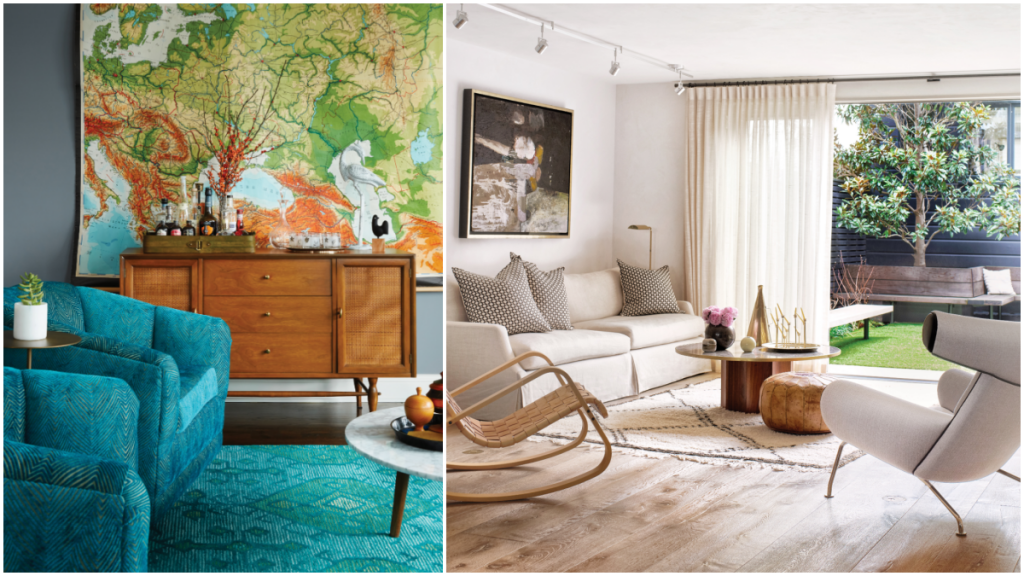By Shelby Deering | Photography by: Dustin Halleck Photography, courtesy Unpatterned (left), Brad Knipstein, courtesy Chairish (right)
Oftentimes, styles come and go, but there’s one design approach that hasn’t budged since it first emerged in the 1940s. Midcentury modern style continues to permeate current homes, with roots that lie at the end of World War II.
“Just as the name suggests, midcentury modern is a design genre that emerged in the middle of the 20th century,” says Tobin Morrison, an interior designer at The Century House in Madison. He says that this style was “very much a product of its time,” since the war forced the U.S. to be extremely thoughtful and intentional about how it made things, “being careful not to gobble up precious materials that might be needed for the war effort.”
Midcentury modern design exploded in popularity in the 1950s and 60s, drawing upon this new age of modernism. With its clean lines, head- turning hues and trademark lighting (such as the eye-catching Sputnik chandelier with a look inspired by the 1957 Russian satellite), midcentury modern has made an indelible print on the design landscape.
Suzanne Augustson, senior interior designer at Curate Design Group, says that’s why midcentury modern design is so iconic — pieces such as the original Herman Miller Eames lounge chair and ottoman continue to be made today, and can be seamlessly incorporated into a range of décor styles.
“At Curate we’re big into combining styles like midcentury modern, traditional and transitional to give interiors some spice and give rooms a collected look,” explains Augustson.
STAYING POWER
While it certainly looks modern by today’s standards, midcentury modern is an enduring style that continues to be timeless and classic.
“Midcentury modern is a classic style because it’s such an understated and easy to pair look,” says Noel Fahden, vice president of merchandising at Chairish, an online vintage marketplace. “The clean lines and minimal details make it easy to incorporate in a variety of styles and spaces.”
As Carly Moeller, registered interior designer and owner of the Chicago- based firm Unpatterned, says, “Function never goes out of style. Whether it’s a sleek, easy-to-clean countertop or a wood furniture piece that doubles as a record cabinet, mid-mod style resonates with today’s appreciation for function and efficiency.”
With more people seeking ease in their interiors, especially since the start of the pandemic, midcentury modern elements can be appreciated just as much today as they were in the last century.
“Though we can’t discount the lasting power of ’Mad Men,’ I also think there are updated ways to incorporate midcentury features that don’t look like a page from a 50’s magazine, but still nod to the style,” Moeller says.
HALLMARKS OF THE STYLE
Today, many interior designers specialize in weaving the midcentury look into interiors for their clients. We asked these experts to share the top hallmarks of this style.
Noel Fahden, Chairish:
- Futuristic shapes, like Arne Jacobsen’s iconic Egg Chair (and yes, it’s shaped a lot like an egg)
- Aerodynamic details, like chiseled pencil legs and sculpted brass pulls
- Brightly-colored upholstery in durable wovens and wools to balance wood furniture pieces
- Anything in plywood, glass, metal, plastic or vinyl, carrying a minimalistic look and a clean silhouette
Carly Moeller, Unpatterned:
- Functional pieces
- An efficient layout or floor plan (think: a kitchen with workstations and practical, yet modern, lighting)
- Natural materials in medium-tone wood finishes
Tobin Morrison, The Century House:
- Simplicity and functionality
- Large patterns and shapes
- Bold textures
Suzanne Augustson, Curate Design Group:
- Brass light fixtures, including the Sputnik style and globe silhouettes
- Solid walnut furnishings
- Acrylic or lucite pieces
WHERE TO SHOP
These shops offer vintage and brand-new midcentury modern décor:
- My Sister & Me (Lake Geneva)
- Lake Geneva Antique Mall
- Elkhorn Antique Flea Market
- The Century House (Madison)
- BC Modern (Milwaukee)
Retro Hues
The experts particularly love these colors for midcentury interiors (left to right):
- Benjamin Moore, Carolina Gull: A green that nods to the past yet looks decidedly current; this hue looks pleasing when paired with walnut furniture.
- Farrow & Ball, Bancha: A stunning olive green, this color is bold, yet versatile, when used in a midcentury space with neutrals.
- Benjamin Moore, Polished Slate: While turquoise is often used in mid-mod designs, this teal takes it down a notch while still having a throwback feel. Pair it with leather furnishings.
